sabbe satta bhavantu sukhi-tatta
TIPITAKA
TIPITAKA AND TWELVE DIVISIONS
Brief historical background
Sutta Pitaka
Vinaya Pitaka
Abhidhamma Pitaka
Twelve Divisions of Buddhist Canons
Nine Divisions of Buddhist Canons
Sutta Piṭaka
— The basket of discourses —Mahāsatipaṭṭhāna Sutta (DN 22) {excerpt} - all infobubbles— Attendance on awareness —Kāyānupassanā
F. Navasivathika Pabba F. Section on the nine charnel grounds F. ஒன்பது இடுகாடு நிலத்தளங்கள் மேலான பிரிவு
When the traditional touchables full of hatred, venomous, and angry on
untouchables, try to harass them, it means that the untouchables are
treading the right path and the touchables were always on the wrong path. People pursuing wrong path always fail. Some Views Papers and Media with ulterior idea are supporting and glorifying such touchables. They should stop this in the interest of peace of the Nation.
Three Ambedkar statues vandalised in UP
![]()
![]()
Sat,28 Jul 2012
Two days after a statue of former Uttar Pradesh chief minister Mayawati
was vandalised in Lucknow, three statues of Dalit icon BR Ambedkar were
damaged in Azamgarh district, police said on Saturday.
Broken pieces of a statue were found in the morning in a field at Katat-Chakkatat
village in Azamgarh, some 270 km from Lucknow, police said.
Two other Ambedkar statues were vandalised and thrown in the fields
of the Nayi Palia and Jiyasath villages, said Superintendent of Police
(SP) Mirza Manzar Beg.
Angry villagers and Bahujan Samaj Party (BSP) workers took to the
streets and blocked a state highway for over four hours, protesting
against the incidents.
Heavy police reinforcements were rushed to the spot and new statues of Ambedkar were installed, police said.

After Mayawati, three Ambedkar statues vandalised in Uttar Pradesh
After Mayawati, now Ambedkar statues vandalized in UP
ALL ABOUT AWAKEN ONES WITH AWARENESS USA
TEXAS
Wat Buddhavas Buddhist temple in Houston, Texas
• Chua Buu Mon, Port Arthur
• Chua Linh-Son Buddhist Temple, Austin
• Maria Kannon Zen Center, Dallas
• Wat Buddhavas of Houston, Houston
• Wat Buddhananachat of Austin, Del Valle
This sutta is widely considered as a the main reference for meditation practice.
|
|
|
| (4) Puna ca·paraṃ, bhikkhave, bhikkhu seyyathāpi passeyya sarīraṃ sivathikāya chaḍḍitaṃ aṭṭhika·saṅkhalikaṃ ni·maṃsa·lohita·makkhitaṃ nhāru·sambandhaṃ, so imam·eva kāyaṃ upasaṃharati: ‘ayaṃ pi kho kāyo evaṃ·dhammo evaṃ·bhāvī evaṃ·an·atīto’ ti. |
(4)
|
|
Iti ajjhattaṃ vā kāye kāyānupassī viharati, bahiddhā vā kāye kāyānupassī viharati, ajjhatta-bahiddhā vā kāye kāyānupassī viharati; samudaya-dhamm·ānupassī vā kāyasmiṃ viharati, vaya-dhamm·ānupassī vā kāyasmiṃ viharati, samudaya-vaya-dhamm·ānupassī vā kāyasmiṃ viharati; ‘atthi kāyo’ ti vā pan·assa sati paccupaṭṭhitā hoti, yāvadeva ñāṇa·mattāya paṭissati·mattāya, a·nissito ca viharati, na ca kiñci loke upādiyati. Evam·pi kho, bhikkhave, bhikkhu kāye kāyānupassī viharati. |
|
F. ஒன்பது இடுகாடு நிலத்தளங்கள் மேலான பிரிவு
மேலும், பிக்குக்களுக்களே, ஒரு பிக்கு, ஒருவேளை அவர் தொலைவான இடத்தில் ஒரு பிரேதம் இடுகாடு நிலத்தளத்தில் எறியப்பட்டு இருப்பதைப் பார்த்துக் கொண்டிருந்தால், ஒரு மனித எலும்புக் கூடு தசைகளில்லாமல் மற்றும் இரத்தம் பூசப்பட்டு,நரம்புகளால் ஒன்றாய் பிடிக்கப்பட்டு,அவர் இந்த மெய்ம்மூலமான kāya உடல்/காய ஆழ்ந்து ஆராய: “இந்த kāya உடல்/காய கூட அவ்வகைப்பட்ட ஒரு இயற்கை ஆற்றல் உடையதாக இருக்கிறது, அதுவும் இப்படி ஆகத்தொடங்கு போக இருக்கிறது, மற்றும் அத்தகைய ஒரு கட்டுப்பாட்டு வரம்புகளற்ற நிலைமை இருந்து வேறல்ல.
இவ்வாறு அவர் kāya in kāya உடல்/காயத்தை காயதுக்குள் கண்காணி வாசம் செய்கிரார், அல்லது காயத்தை காயதுக்கு வெளியே கண்காணி வாசம் செய்கிரார், அல்லது காயத்தை காயதுக்கு உள்ளே மற்றும் வெளியே கண்காணி வாசம் செய்கிரார்;புலன்களால் உணரத்தக்க எழுச்சி கண்காணி வாசம் செய்கிரார், மற்றும் புலன்களால் உணரத்தக்கதை கடந்துசெல்லுவதை கண்காணித்து வாசம் செய்கிரார்; இல்லாவிடில் எச்சரிக்கையாயிருக்கிற உணர் உடனிருக்கிறதை,சும்மா வெறும் ஓர்அளவு ஞானம் மற்றும் ஓர்அளவு paṭissati என எண்ணி பற்றறு வாசம் செய்கிரார்.
| (5) Puna ca·paraṃ, bhikkhave, bhikkhu seyyathāpi passeyya sarīraṃ sivathikāya chaḍḍitaṃ aṭṭhika·saṅkhalikaṃ apagata·maṃsa·lohitaṃ nhāru·sambandhaṃ, so imam·eva kāyaṃ upasaṃharati: ‘ayaṃ pi kho kāyo evaṃ·dhammo evaṃ·bhāvī evaṃ·an·atīto’ ti. |
(5)
|
|
Iti ajjhattaṃ vā kāye kāyānupassī viharati, bahiddhā vā kāye kāyānupassī viharati, ajjhatta-bahiddhā vā kāye kāyānupassī viharati; samudaya-dhamm·ānupassī vā kāyasmiṃ viharati, vaya-dhamm·ānupassī vā kāyasmiṃ viharati, samudaya-vaya-dhamm·ānupassī vā kāyasmiṃ viharati; ‘atthi kāyo’ ti vā pan·assa sati paccupaṭṭhitā hoti, yāvadeva ñāṇa·mattāya paṭissati·mattāya, a·nissito ca viharati, na ca kiñci loke upādiyati. Evam·pi kho, bhikkhave, bhikkhu kāye kāyānupassī viharati. |
|
மேலும், பிக்குக்களுக்களே, ஒரு பிக்கு, ஒருவேளை அவர் தொலைவான இடத்தில் ஒரு பிரேதம் இடுகாடு நிலத்தளத்தில் எறியப்பட்டு இருப்பதைப் பார்த்துக் கொண்டிருந்தால், ஒரு மனித எலும்புக் கூடு தசைகளில்லாமல் மற்றும் இரத்தம் இல்லாமல்,நரம்புகளால் ஒன்றாய் பிடிக்கப்பட்டு,அவர் இந்த மெய்ம்மூலமான kāya உடல்/காய ஆழ்ந்து ஆராய: “இந்த kāya உடல்/காய கூட அவ்வகைப்பட்ட ஒரு இயற்கை ஆற்றல் உடையதாக இருக்கிறது, அதுவும் இப்படி ஆகத்தொடங்கு போக இருக்கிறது, மற்றும் அத்தகைய ஒரு கட்டுப்பாட்டு வரம்புகளற்ற நிலைமை இருந்து வேறல்ல.
இவ்வாறு அவர் kāya in kāya உடல்/காயத்தை காயதுக்குள் கண்காணி வாசம் செய்கிரார், அல்லது காயத்தை காயதுக்கு வெளியே கண்காணி வாசம் செய்கிரார், அல்லது காயத்தை காயதுக்கு உள்ளே மற்றும் வெளியே கண்காணி வாசம் செய்கிரார்;புலன்களால் உணரத்தக்க எழுச்சி கண்காணி வாசம் செய்கிரார், மற்றும் புலன்களால் உணரத்தக்கதை கடந்துசெல்லுவதை கண்காணித்து வாசம் செய்கிரார்; இல்லாவிடில் எச்சரிக்கையாயிருக்கிற உணர் உடனிருக்கிறதை,சும்மா வெறும் ஓர்அளவு ஞானம் மற்றும் ஓர்அளவு paṭissati என எண்ணி பற்றறு வாசம் செய்கிரார்.
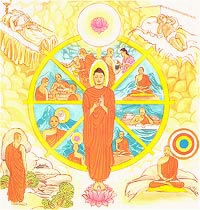 |
Verse 273. The Eight-fold Path Is Best
Explanation: Off all paths, the eight-fold path is the greatest. |
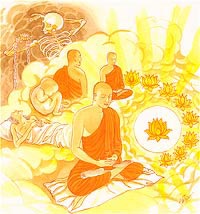 |
Verse 274. The Only Path To Purity
Explanation: This is the path. There is no other for the achievement |
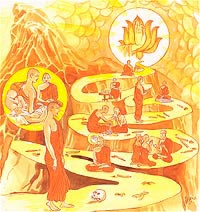 |
Verse 275. The Path To End Suffering
Explanation: If you follow this path, you will reach the termination |
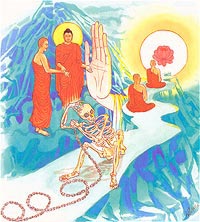 |
Verse 276. Buddhas Only Shows The Way
Explanation: The effort must be made by yourself. The Buddhas |
Dhammapada Verses 273, 274, 275 and 276
Pancasatabhikkhu VatthuMagganatthangiko1 settho
saccanam caturo pada2
virago settho dhammanam3
dvipadananca cakkhuma.Eseva maggo natthanno
dassanassa visuddhiya
etanhi tumhe patipajjatha
marassetam pamohanam.Etanhi tumhe patipanna
dukkhassantam karissatha
akkhato vo rnaya maggo
annaya sallakantanam.Tumhehi kiccamatappam
akkhataro tathagata
patipanna pamokkhanti
jhayino marabandhana.Verse 273: Of paths, the Path of Eight Constituents is the noblest; of
truths, the Four Noble Truths are the noblest; of the dhammas, the absence of
craving (i.e., Nibbana) is the noblest; of the two-legged beings, the All-Seeing
Buddha is the noblest.Verse 274: This is the only Path, and there is none other for the purity of
vision. Follow this Path; it will bewilder Mara.Verse 275: Following this Path, you will make an end of dukkha. Having myself
known the Path which can lead to the removal of the thorns of moral defilements,
I have shown you the Path.Verse 276: You yourselves should make the effort; the Tathagatas (Buddhas)
only can show the way. Those who practise the Tranquillity and Insight
Meditation are freed from the bond of Mara.
1. atthangiko: Ariya Atthangika Magga, or the Noble Path of Eight
Constituents. This is the Path pointed out by the Buddha for liberation from the
round of existences. The Eight Constituents are: right view, right thinking,
right speech, right action, right living, right effort, right mindfulness and
right concentration.2. caturo pada: Cattari Ariyasaccani, or the Four Noble Truths. These are the
four Truths upon which the whole doctrine of the Buddha is based. They are: (a)
the Noble Truth of Dukkha; (b) the Noble Truth of the Cause of Dukkha, i.e.,
craving; (c) the Noble Truth of the Cessation of Dukkha; and (d) the Noble Truth
of the Path leading to the Cessation of Dukkha. (N.B. Dukkha, in this context,
means the five aggregates of attachment or Pancupadanakkhandha).3. dhamma: both conditioned and unconditioned things.
The Story of Five Hundred Bhikkhus
While residing at the Jetavana monastery, the Buddha uttered Verses (273) to
(276) of this book, with reference to five hundred bhikkhus.Five hundred bhikkhus, after accompanying the Buddha to a village, returned
to the Jetavana monastery. In the evening they talked about the trip, especially
the nature of the land, whether it was level or hilly, clayey or stony, etc. The
Buddha came to them in the midst of their conversation and said to them, “Bhikkhus,
the path you are talking about is external to you; a bhikkhu should only be
concerned with the path of the Noble Ones (ariyas) and strive to do what should
be done for the attainment of the Ariya Path (Magga) that leads to the
realization of the Perfect Peace (Nibbana).”Then the Buddha spoke in verse as follows:
Verse 273: Of paths, the Path of Eight
Constituents is the noblest; of truths, the Four Noble Truths are the
noblest; of the dhammas, the absence of craving (i.e., Nibbana) is the
noblest; of the two-legged beings, the All-Seeing Buddha is the
noblest.Verse 274: This is the only Path, and there is
none other for the purity of vision. Follow this Path; it will
bewilder Mara.Verse 275: Following this Path, you will make an
end of dukkha. Having myself known the Path which can lead to the
removal of the thorns of moral defilements, I have shown you the Path.Verse 276: You yourselves should make the effort;
the Tathagatas (Buddhas) only can show the way. Those who practise the
Tranquillity and Insight Meditation are freed from the bond of Mara.
At the end of the discourse those five hundred bhikkhus attained arahatship.
Texas
Wat Buddhavas Buddhist temple in Houston, Texas
http://en.wikipedia.org/wiki/Wat_Buddhavas
| This article does not cite any references or sources. (June 2010) |
| Wat Buddhavas | |
|---|---|
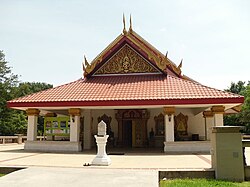 |
|
| Information | |
| Denomination | Theravada |
| Founded | April 5, 1982 |
| Founder(s) | Phra Promwachirayana |
| Teacher(s) | Manasnit Klinkul, Suwajee Munjeen, Patthanan Apiwitkullatat |
| Director(s) | Phrachan Kumchan |
| Abbot(s) | Most Venerable Sunthorn (Ajahn Prachan Kamchan) |
| Reverend(s) | Phra Ajahn Ken Kamalo |
| Address | 6007 Spindle Dr., Houston, TX 77086-3930 |
| Country | United States |
| Website | [1] |
Wat Buddhavas is a Buddhist Temple located on Spindle Dr. at Antoine Rd. in Houston, Texas.
Contents
• Chua Buu Mon, Port Arthur
http://en.wikipedia.org/wiki/Chua_Buu_Mon
| Chua Buu Mon | |
|---|---|
 |
|
| The main shrine hall | |
| Information | |
| Denomination | Theravada |
| Founded | August 15, 1987 |
| Abbot(s) | Most Venerable Huyen Viet |
| Reverend(s) | Rev. Bui Thanh Nhan (Thich Tri Quang), Bhante Kassapa Bhikkhu |
| Address | 2701 Proctor Street, Port Arthur, TX 77640 |
| Country | United States |
| Website | www.buumon.org/ |
Chua Buu Mon is a Buddhist Temple located on Proctor Street in Port Arthur, Texas.
Contents
• Chua Linh-Son Buddhist Temple, Austin
http://en.wikipedia.org/wiki/Chua_Linh-Son_Buddhist_Temple
| Chua Linh-Son | |
|---|---|
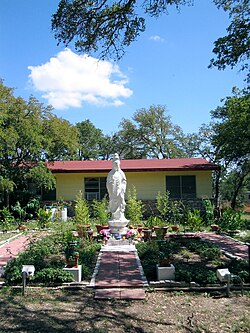 |
|
| Information | |
| Denomination | Theravada |
| Founded | 1998 |
| Abbot(s) | Venerable Thich Tri-Hue |
| Reverend(s) | Thich Hue-Minh |
| Address | 4604 Duval Rd., Austin, TX 78727 |
| Country | United States |
| Website | [2] |
Chua Linh-Son is a Buddhist Temple, located on 4604 Duval Rd. Austin, Texas.
Contents
• Maria Kannon Zen Center, Dallas
http://en.wikipedia.org/wiki/Maria_Kannon_Zen_Center
| Maria Kannon Zen Center | |
|---|---|
 |
|
| Ruben Habito, guiding teacher | |
| Information | |
| Denomination | Sanbo Kyodan |
| Founded | 1991 |
| Teacher(s) | Ruben Habito Valerie Pettys Helen Cortes |
| Address | 6532 Hunnicut Rd, Dallas, TX 75227 |
| Country | United States |
| Website | http://www.mkzc.org/ |
Maria Kannon Zen Center (MKZC) is a non-profit practice center in the Sanbo Kyodan tradition of Zen Buddhism, located in Dallas, Texas and founded in 1991 by the guiding teacher Ruben Habito (a Dharma heir of Yamada Koun).[1] MKZC derives its name by combining the names of the Virgin Mary of Christianity and Kannon bodhisattva of Buddhism. It is actually the name of a figurine revered in Japan during Christian persecution there.[2] Many of the MKZC members are individuals who consider themselves Christian, with Habito himself being a practicing Catholic and former Jesuit priest.[3] MKZC is listed with the American Zen Teachers Association.[1]
Contents
• Wat Buddhavas of Houston, Houston
http://en.wikipedia.org/wiki/Wat_Buddhavas_of_Houston
| This article does not cite any references or sources. (June 2010) |
| Wat Buddhavas | |
|---|---|
 |
|
| Information | |
| Denomination | Theravada |
| Founded | April 5, 1982 |
| Founder(s) | Phra Promwachirayana |
| Teacher(s) | Manasnit Klinkul, Suwajee Munjeen, Patthanan Apiwitkullatat |
| Director(s) | Phrachan Kumchan |
| Abbot(s) | Most Venerable Sunthorn (Ajahn Prachan Kamchan) |
| Reverend(s) | Phra Ajahn Ken Kamalo |
| Address | 6007 Spindle Dr., Houston, TX 77086-3930 |
| Country | United States |
| Website | [1] |
Wat Buddhavas is a Buddhist Temple located on Spindle Dr. at Antoine Rd. in Houston, Texas.
Contents
• Wat Buddhananachat of Austin, Del Valle
http://en.wikipedia.org/wiki/Wat_Buddhananachat_of_Austin
|
|
This article needs additional citations for verification. (May 2011) |
| Wat Buddhananachat | |
|---|---|
 |
|
| Information | |
| Denomination | Theravada |
| Founded | April, 1986 |
| Founder(s) | Ven. Phramaha Thewa Pribueng |
| Teacher(s) | Ven. Phra Somchay Mali |
| Director(s) | Mr. Sydney Ouk (President/Treasurer) |
| Abbot(s) | Most Ven. Phramaha Bancha Temprom |
| Reverend(s) | Ven. Phra Raem Poonnongwaeng |
| Address | 8105 Linden Rd., Del Valle, TX 78617 |
| Country | United States |
| Website | [1] |
Wat Buddhananachat is a Buddhist Temple located about 20 miles southeast of Downtown, on Linden Rd. in Del Valle, Texas.
This Buddhist temple was established in April, 1986 (in corporated on
August 4, 1986) as a nonprofit organization to serve as a center for
religious and cultural activities for Theravadic Buddhist belonging to
different ethnic communities in central Texas.
Contents
THE STUPID MONKEYS
[24]
| O |
NCE upon a time a king gave a holiday to all the people
in one of his cities.
The king’s gardener thought to himself:
“All my friends are having a holiday in the city.
I could go into the city and enjoy myself with them
if I did not have to water the trees here in this garden.
I know what I will do. I will get the Monkeys to water
the young trees for me.” In those days,
a tribe of Monkeys lived in the king’s garden.
So the gardener went to the Chief of the Monkeys,
and said: “You are lucky Monkeys
to be living in the king’s garden.
You have a fine place to play in.
You have the best of food—nuts, fruit,
and the young shoots of trees to eat.
You have no work at all to do. You can play all day,
every day. To-day my friends are having a holiday in the city,
and I want to enjoy myself with them.
Will you water the young trees so that I can go away?”
“Oh, yes!” said the Chief of the Monkeys.
“We shall be glad to do that.”
[25] “Do not forget to water the trees when the sun goes down.
See they have plenty of water, but not too much,”
said the gardener. Then he showed them
where the watering-pots were kept, and went away.
![[Illustration]](http://www.mainlesson.com/books/babbitt/morejataka/zpage025.gif)
When the sun went down the Monkeys took the watering-pots,
and began to water the young trees.
“See that each tree has enough water,”
said the Chief of the Monkeys.
“How shall we know when each tree has enough?”
they asked. The Chief of the Monkeys had no good answer,
so
[26] he said: “Pull up each young tree
and look at the length of its roots.
Give a great deal of water to those with long roots,
but only a little to those trees that have short roots.”
Then those stupid Monkeys pulled up all the young trees
to see which trees had long roots and which had short roots.
When the gardener came back the next day,
the poor young trees were all dead.
http://www.texasoutside.com/texas-kids-activities/index.html
Fun Things For Kids To See & Do In Texas
Texas Outside has lots of things for you to see
and do, so this page is dedicated to fun activities and things to do for
kids. Our children have enjoyed a lot of these adventures like kids day
or summer camps, mazes, bike trails, museums, water parks, amusement
rides, miniature golf, bumper cars, kids museums, or just a day in the
park grilling dogs, tossing balls, or fishing. Below are our
recommendations on some things to do with your kids in Texas - all are
great family activities.
Amusement Parks
 |
Everybody loves Shamu at Sea World and What kid doesn’t love a roller coaster, cotton |
Boating & Fishing
 |
Texas has over 125 lakes spread |
Caves and Caverns
 |
Texas is riddled with thousands of caves. |
Christmas Tree Farms
 |
Get a REAL tree on a REAL farm at Devine |
Dude Ranches
 |
Once in their lifetime, you need to take |
Events and Festivals
 |
You will find games of |
Horseback Riding
 |
Need someplace the kids can go for an |
Mazes
 |
If you’re looking for something fun and Most of the mazes have other activities and fun things |
Museums & Science Centers
 |
There is no limit to what your children |
Pumpkin Patches
| Meet the baby animals from a kangaroos to pigs, create a scarecrow, paint a pumpkin, ride a hayride or train or just pick out that perfect pumpkin for carving or eating. Whatever your day in the pumpkin patch brings it will be great entertainment for the entire family and an opportunity for awesome fall pictures. |
Summer Camps
 |
What is better than fun, sun and |
Train Rides
 |
The magic of the train comes to life |
Vacations For Kids & Families
 |
It just doesn’t get much better than a |
Water Parks
 |
On a hot Texas summer day, it just |
Wildlife Preserves & Parks
 |
An exciting safari adventure filled with |
Zip Lines
 |
Multiple Texas Locations |
For a thrilling adventure for kids over |
Zoos
 |
It doesn’t get much better than taking |
Fun Resources for Kids
| Texas Parks and Wildlife | Check out this website for some great ideas for outdoor and indoor craft activities and at the same time learn a little history of Texas, safety outdoors, animals & flower facts and much more. |
| Ways to make personal contact with living things by touch, feel, and smell to develop a relationship with the outdoors. |
North Texas Kids Family Expo Goes For A ‘Hey’ Ride




